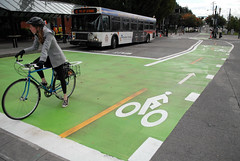According to Mike Wetter, the Senior Advisor to Metro Council President David Bragdon, the U.S. Department of Transportation is on the verge of a decision that could rapidly speed up the use of innovative bikeway treatments across America. Among supporters of a change to the policy is a national association of city transportation planners and U.S. Congressman Earl Blumenauer.
Currently, due to outdated federal standards, many bikeway designs that are common in Europe and Canada — like bike boxes, colored pavement markings, bike-only signals, and buffered bike lanes — are still considered “experimental” in the U.S.. This lack of official endorsement by the FHWA means city planners cannot use federal funds to install them and they encounter a host of significant barriers when trying to implement them. Wetter, along with transportation planners at PBOT and cities across the country, think current policies are unfair to urban jurisdictions and they might finally be close to changing them.
[Read more about efforts to work around these outdated manuals in my article about the ‘Cities for Cycling’ initiative.]
“… there is currently not a coherent national program and policy framework for cycling infrastructure in urban areas…”
— Mike Wetter, Metro
Wetter says that in part due to Metro’s work in raising this issue to DOT Secretary Ray LaHood’s office last fall, the US DOT may soon give “interim approval” to the designs which would expedite their use across the country.
On October 12, 2009, Wetter explained the “Federal barriers to active transportation” in a memo to two Obama administration officials; Assistant Secretary for Transportation Policy Polly Trottenberg and Linda Lawson, Director of the Office of Safety Energy and Environment.
Wetter wrote (emphasis mine):
“… many of the issues stem from the fact that there is currently not a coherent national program and policy framework for cycling infrastructure in urban areas. There are national programs and policy frameworks guiding automobile, air, marine and transit. The bicycle is now being regarded as a serious transportation option by many US cities and we are finding ourselves increasingly challenged by the vacuum that exists in national bicycle policy.”
A follow-up memo written by Wetter and PBOT’s head traffic engineer Rob Burchfield and bicycle coordinator Roger Geller explained that the American Association of State Highway Transportation Officials’ (AASHTO) “Guide for Development of Bicycle Facilities” and the FHWA’s Manual on Uniform Traffic Control Devices have not kept up with the times. The memo states, “These two documents provided adequate designs and traffic controls for an era when only a hardy few used bicycles for transportation.”
“It took over five years for a treatment as simple as a shared lane marking to get formally adopted. Cities are not willing to wait that long to increase citizen safety.”
The memo referred to “the onerous nature of the MUTCD” and said the current situation is “suboptimal for many reasons.” The memo goes on to state that the situation created by strict adherence to the MUTCD and AASHTO guide is “inequitable,” “risky,” “inefficient,” “expensive,” “misplaced,” “unpredictable,” “regulatory,” “slow,” and “moving backwards.”
As an example of how slow the feds are to respond to cities’ urgent needs to provide transportation services to non-motorized vehicles, the memo highlights the saga around the use and formal adoption of shared-lane markings (a.k.a. sharrows):
“The speed with which new designs are considered, debated and implemented far outpaces the ability of AASHTO and FHWA to respond under existing processes. For example, an informal count of jurisdictions across the country… found that more than 80 jurisdictions in 30 states were using shared lane markings before they were adopted into the MUTCD. It took over five years for a treatment as simple as a shared lane marking to get formally adopted. Cities are not willing to wait that long to increase citizen safety.”
These federal policy barriers have major impacts in cities like San Francisco, Chicago, Boston and Portland where bike planners and engineers want to use new tools to serve high volumes of bike traffic (in July 2008 PBOT officials filed an FHWA “request to experiment” with green colored bike boxes).
“As the Secretary himself has noted, we’ll have to move beyond current design standards if we want to create truly livable communities, where people can walk and bicycle safely.”
— Congressman Earl Blumenauer
As a solution, Wetter and his partners at PBOT want the FHWA to partner more closely with cities on research, innovation and adoption of best practices. Specifically, they want the US DOT to work in cooperation with the National Association of City Transportation Officials (NACTO, the city version of AASHTO), provide interim approval for several new (in the U.S.) bikeway designs, work with NACTO to develop the forthcoming “Cities for Cycling Urban Bikeway Design Guide” and implement the findings of an FHWA-sponsored fact-finding mission to bike-friendly cities in Europe that took place in May 2009.
Wetter says that while the interim approval has not been officially granted, the US DOT has expressed a keen interest in addressing the issue: “We appear close to achieving our first win.”
Staffers from U.S. Congressman Earl Blumenauer’s office have also been engaged with this issue. Blumenauer told me via email today that a quick adoption of best practices and design principles for transportation projects, “is essential if we are to make our roads truly safe for Americans who choose to walk and bicycle.”
Blumenauer says he has spoken with Sec. LaHood about this issue and that both of their staffs, along with transportation planners from the City of Portland, Metro, and at cities across the country are working together to find a solution. “As the Secretary himself has noted, we’ll have to move beyond current design standards if we want to create truly livable communities, where people can walk and bicycle safely.”
We’ll keep you posted if and when the interim approval is granted.


